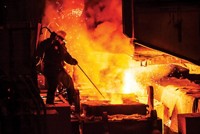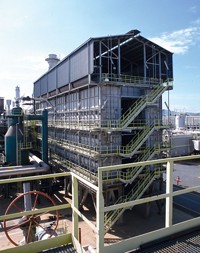Advertisement
Grab your lab coat. Let's get started
Welcome!
Welcome!
Create an account below to get 6 C&EN articles per month, receive newsletters and more - all free.
It seems this is your first time logging in online. Please enter the following information to continue.
As an ACS member you automatically get access to this site. All we need is few more details to create your reading experience.
Not you? Sign in with a different account.
Not you? Sign in with a different account.
ERROR 1
ERROR 1
ERROR 2
ERROR 2
ERROR 2
ERROR 2
ERROR 2
Password and Confirm password must match.
If you have an ACS member number, please enter it here so we can link this account to your membership. (optional)
ERROR 2
ACS values your privacy. By submitting your information, you are gaining access to C&EN and subscribing to our weekly newsletter. We use the information you provide to make your reading experience better, and we will never sell your data to third party members.
Green Chemistry
A simply smashing ammonia synthesis
Mechanochemistry may offer greener way to unite nitrogen and hydrogen to make key fertilizer ingredient
by Mark Peplow, special to C&EN
November 22, 2021

A reactor that uses steel balls to smash together nitrogen, hydrogen, and an iron catalyst can produce a continuous stream of ammonia, even at room temperature and atmospheric pressure. The discovery comes hard on the heels of two other mechanochemical methods for ammonia synthesis, from research groups seeking environmentally friendly alternatives to the leviathan Haber-Bosch process.
Haber-Bosch combines N2 and H2 over an iron catalyst at high pressures and temperatures, and globally makes about 150 million tons of ammonia per year, largely for fertilizer production. It also consumes vast amounts of energy and causes roughly 1% of human-made CO2 emissions. The majority of those emissions come from the production of one of the key ingredients, H2, from methane or other fossil fuels.
Researchers have spent decades investigating alternative ammonia syntheses based on electrochemistry, photochemistry, plasma-based processes, and molecular catalysts that mimic those involved in biological nitrogen fixation. These approaches still face major drawbacks, from low yields to scale-up difficulties.
Mechanochemistry is the latest contender, and its simplicity is a key attraction. It relies on a ball mill, a rapidly rotating vessel that can grind up reagents with steel balls to drive mechanochemical reactions.
Researchers led by Ferdi Schüth at the Max Planck Institute for Coal Research built a ball-milling vessel that could accommodate a continuous flow of gas. They loaded the vessel with powdered iron and included a dash of cesium, along with some small steel balls. Cesium donates electrons to iron atoms to improve their catalytic activity, and similar promoters are already used in Haber-Bosch catalysts.
Schüth’s team passed a mixture of hydrogen and nitrogen over the churning balls, testing the reaction under different conditions (Angew. Chem., Int. Ed. 2021, DOI: 10.1002/anie.202112095). At room temperature and 20 atmospheres of pressure, the output gas contained up to 0.42% ammonia by volume, the remainder being unreacted nitrogen and hydrogen. Smaller amounts of ammonia were also produced at atmospheric pressure.
These are tiny quantities, but the system could produce ammonia continuously for over 60 h, and Schüth says that unreacted gases could, in principle, be piped back into the reactor.
“This is clearly an important step in the right direction,” says Carsten Sievers at Georgia Institute of Technology, who also works on mechanochemical ammonia synthesis and was not involved in the research.
Schüth’s team has started to investigate the underlying chemistry of the process. “From the results that we have so far, we actually think that it’s very close to what’s happening in the industrial Haber-Bosch process,” says Steffen Reichle, Schüth’s graduate student who worked on the experiments.
Schüth suspects that the milling process creates hot spots in the reactor, as well as short-lived defects in the iron catalyst that activate nitrogen, as well as fleeting hot spots that may help to push the reaction forwards. “If we understand what makes the catalyst active under milling conditions, maybe there are other ways of creating these defects in a deliberate manner without the milling, and thus create a more active catalyst,” he says.
Schüth’s synthesis is similar to two other recently reported methods. Last year, Jong-Beom Baek at Ulsan National Institute of Science and Technology unveiled a two-step mechanochemical ammonia synthesis with a much higher yield (Nat. Nanotechnol. 2020, DOI: 10.1038/s41565-020-00809-9).
The process involves milling iron powder with nitrogen to form nitrogenated iron particles. Then, hydrogen is passed over these particles to generate ammonia. At 2 atmospheres of pressure and 45 °C, the output gas stream contains 82.5% ammonia by volume, and the residual iron powder could be reused. “They get good conversion, it’s a very good piece of work,” Schüth says.
Baek says his team has recently pushed the reaction’s ammonia yield above 90%, scaled up the process 60-fold to a 15 liter vessel, and improved the catalyst with the help of a promoter. They are now trying to adapt the stepwise method so it offers continuous ammonia production, akin to Schüth’s approach. “This is the way to go,” Baek says. “For commercialization, we have to develop a continuous process.”
Ammonia production currently happens at enormous centralized sites, but Baek suggests that a smaller-scale mechanochemical approach could underpin a more distributed system that makes ammonia closer to the point of use, reducing transportation costs.
Baek also hopes that the process could be teamed with green hydrogen production, made by electrolyzing water with renewable electricity. After converting hydrogen into liquid ammonia—which is much easier to transport over long distances—the hydrogen could then be regenerated where it is needed. “The most critical hurdle in the hydrogen economy is transportation and storage. So if we can produce ammonia in this way, we can boost the hydrogen economy,” Baek says.
Meanwhile, Sievers has made ammonia with the help of titanium powder, which transforms into a titanium nitride catalyst during milling. This also worked at low temperature and pressure, although the ammonia was only released many hours after milling had ceased (ACS Energy Lett. 2020, DOI: 10.1021/acsenergylett.0c01895).
Sievers is skeptical that ball milling will ever be a direct competitor to existing ammonia plants. “I don’t see how Haber-Bosch, as a major industrial process, will be replaced,” he says. But he agrees that mechanochemistry could be useful for making ammonia in remote locations, using renewable or even mechanical energy. For example, his team has calculated, based on the energy demands of the reaction, that an industrial ball mill powered by 200 solar panels could produce enough ammonia to fertilize 10hectares of farmland.
“If you want to make fertilizers in a more distributed way, I think that this technology is really interesting,” Sievers says. “In its most crude form, you could even get mechanical energy from a windmill, a river, or a donkey.”





Join the conversation
Contact the reporter
Submit a Letter to the Editor for publication
Engage with us on Twitter